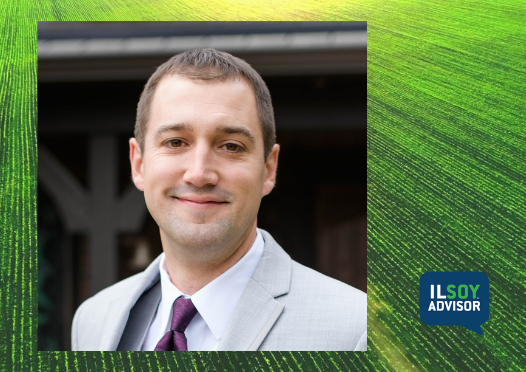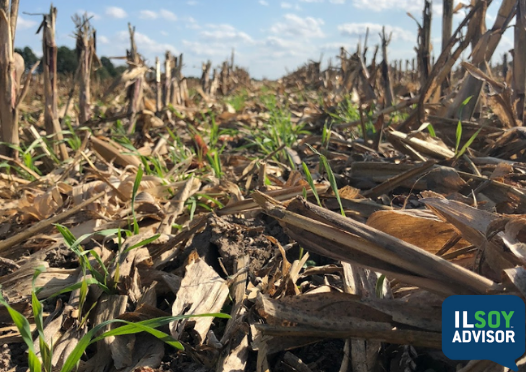ILSOYADVISOR POST
SHOWCASE FARMER: Ross Pauli
The farmer. Ross Pauli produces corn and soybeans on 700 acres near Edwards in north-central Illinois. He rents most of the acreage from 15 different landowners. “Because I’ve been in this area my whole life, I know everyone and it’s important that I get along with everyone,” he says.
Pauli says that with time he has built good relationships with his landowners by convincing them that trying new things, like cover crops, can provide benefits to improve the quality of their land.
Environmental challenge. Pauli farms in the Kickapoo Creek watershed, which drains into the Illinois River basin and then into the Mississippi. “Since the 1980s, I’ve run the gamut of conservation tillage for corn and soybeans,” he explains.
Today, he farms 100 percent of his ground no-till and is continuing to expand the use of cover crops in his cropping rotations.
Best management practices. Raising cattle in partnership with a neighbor helped Pauli understand the value of cover crops. “When we had livestock, we always had ground in hay and our best-yielding corn was always grown in what had been in hay the previous year.”
As luck would have it, the neighbor opted to get out of the livestock business about the same time that Pauli first learned of cover crops. “That first year I started small, but I’ve had enough success with cover crops that I’ll have cover crops in rotation on 80 percent of my farm this year.”
He was one of the first farmers in his area to join the Conservation Stewardship Program (CSP). Authorized in the 2008 Farm Bill, CSP requires growers to maintain a higher level of conservation on their land and includes a number of production practices to promote sustainable farming, including the use of cover crops. Pauli is currently on the county committee for the Farm Service Agency (FSA) and has served as a board member of the Soil and Water Conservation District (SWCD).
Pauli admits that his commitment to trying new things has raised some eyebrows over the years. He remembers when his work with no-till corn caught his grandfather’s eye. “He warned me that I was going to lose that farm, ‘with all that trash left on the surface.’”
“At first they said, ‘Why are you doing this? What is this?’ And I explained to them that I believe in making the land better than I found it. I’ve always believed that, even when it was normal to plow cornstalks and chisel the beans,” he says.
Helping landowners manage the risk of new production practices has helped. “For the first year, I cover all the expenses, taking the risk off the landowners,” he explains. “I tell them, ‘You don’t need to worry about the risk, you can just reap the benefits of improved soil health.’”
With time, he says, the tone of the conversations with his landlords has changed. “They trust me now, so they are more willing to support anything that I think will help improve the quality of their soils.”
Pauli farms all types of soil, with approximately 25 percent of the ground being what he describes as good prairie soils and the rest a combination of Highly Erodible Land (HEL), flat, timber soil and clay soil.
Pauli says the timber soil has its own unique characteristics that make it more difficult to farm. “It stays wet in the spring and turns dry in the summer,” he explains. “It gets powdery if it’s worked when it’s dry, then if it would rain, it would harden like cement.”
Pauli says the combination of no-till and cover crops has helped improve his lighter timber soils.
“If you don’t have bare soil, it doesn’t turn into concrete.”
He manages his HEL with terraces and waterways. Through the CP33 habitat buffers plan of the Conservation Reserve Program he planted 30-foot strips of native prairie grasses and forbs on fields adjacent to forested areas. “In those fields next to trees, we weren’t really getting much of a crop due to shading, anyway,” he explains. An added benefit is the field border helps filter surface runoff and reduce the formation of gullies in the area’s surrounding woods.
It’s also helped with yield losses to wildlife. “Deer will still get the first row, but the feeding is not as bad in the interior of the field. We just expect that first row to be deer food.
“You have to remember that you’re spending money wherever you plant, so if you try to plant to the tree line, you’re spending money on seed, fertilizer and chemicals, and many times that area would only yield 20 bushels per acre due to shading and wildlife feeding,” he says. “But the rest of the field is yielding 175 bushels per acre; you’re losing a lot of money on the edge of that field. If you don’t have to put the inputs out, you’re saving money and your yield per acre goes up when you farm the most productive parts.”
Sutainable focus for 2015. Pauli will expand the use of cover crops on the acres he farms, adding them in areas with lighter and more rolling soils.





Comments
Add new comment